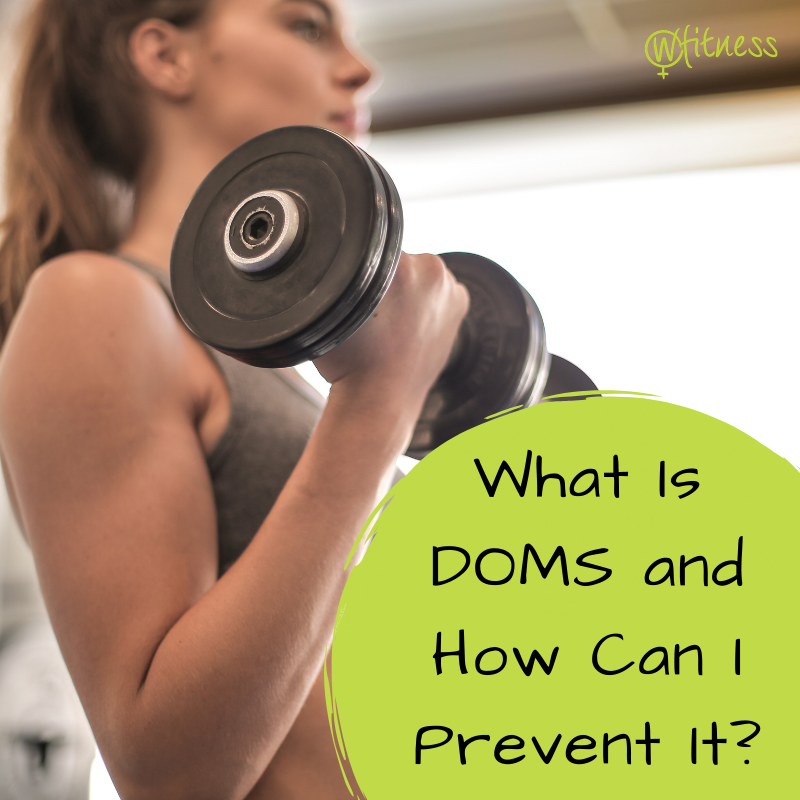DOMS – Delayed Onset Muscle Soreness – is the uncomfortable feeling you might get a few days after your workout. It can range from slightly noticeable to severe (where even standing up and walking can become a real effort). You will most likely feel DOMS after starting a new workout, changing your workout routine, or increasing the intensity of your current workout. Anyone can develop DOMS, whether your a beginner, or a professional athlete!
What causes DOMS?
When your muscles are required to work harder than they’re used to (when you start a workout routine or increase the intensity of your current one) or in a different way (such as changing your routine) it is believed to cause microscopic damage to the muscle fibres. This damage can cause muscle soreness or stiffness.
It is often mistakenly believed that DOMS can be caused by a build up of lactic acid, however, lactic acid isn’t involved in this process.
The effects of DOMS will gradually reduce over time as you settle into your new routine or workout programme, and your body adapts to the training.
So, is DOMS actually good for me?
Whilst we need to achieve hypertrophy in order to build our muscle (this is where the muscle tissue is placed under stress when taking part in resistance exercises, causing micro-tears in the muscle fibres which the body repairs, and in turn makes the muscle larger) there is no strong evidence that having severe DOMS leads to greater strength or hypertrophy gains.
It can have phychological advantages as you’ll feel like you’ve had a good workout, and therefore this could lead you to feel more body confident and positivity towards yourself. Plus, it can often stop you binge eating as the soreness is a reminder of your hard work in the gym.
However, a few things to be wary about DOMS are:
- Severe DOMS could leave you unable to fully complete your next workout to the best of your ability – if you feels DOMS after a change in your workout programme, it’s often best to take a few rest days to recover,
- If you feel severe DOMS after your workout when you’ve been doing the same routine for several months, it could be that the intensity of your workout is putting too much strain and stress on your body and increasing your risk of overtraining. It’s important to challenge yourself, but consistant training should lead to a reduction of DOMS over time,
- Excessive DOMS after your workouts could indicate you’re not taking enough time to rest your body, or your nutrition isn’t matched with your exercise routine needs.
So although DOMS is more than likely after a change in routine, it shouldn’t be something you suffer after every workout – if you do, it could be time to lower your programme or speak to a professional to help you out.
Can I treat DOMS?
DOMS can last up to 5 days and there is no proven way to treat it. However, if you are suffering, here are a few things that might help ease the symptoms:
- rest
- ice packs
- painkillers
- massage
It doesn’t usually require medical intervention, however, if the pain becomes unbearable, you experience heavy swelling or your urine becomes dark, you should seek medical advice.
How can I prevent DOMS?
To reduce DOMS we need to develop a training plan that focuses on progressive overload which will consistently challenge your body, but not push it to the point of suffering DOMS for the next week! This is something we focus on at W Fitness, gradually increasing the intensity of your workout.
However, if you feel you’re going to get DOMS (maybe you’ve just completed your first workout after a break), here are a few things to try and prevent the severity:
- Massage – A study in the Journal of Athletic Training found that just a 10 minute massage 3 hours after exercise reduced the severity of DOMS by 30%. This could either be through a sports massage or simply using a foam roller at home to help reduce muscular pain.
- Cold Water Immersion – It has been found that cold water immersion may delay DOMS after exercise but it didn’t have a significant effect on muscle soreness – so if you’re a fan of a cold shower, give it a go – but don’t feel inclined if you don’t enjoy them.
- Stretching – Stretching before and after your workout can reduce the effect of DOMS slightly. Although it will not take the pain away, stretching can provide you with some relief at home – aim to hold static stretches for 30 seconds. Plus, stretching has so many other benefits, we highly recommend doing this anyway!
If you’re looking for guidance on your workout programme, book in for a free visit with us where we can help you create a plan perfect for you!
Alternatively, if you’re not local to W Fitness, try our online membership site, TonedIn10, where we have home workouts from beginner to advanced, so you can easily progress and increase the intensity gradually!
Love,
Hannah & Caroline xx
